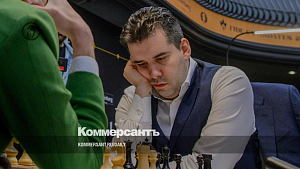4 May 2015
A Tale of How Evgeny Tomashevsky Built a Summer Cottage for Himself
Dmitry Kryakvin reviews the success of Tomashevsky in Tbilisi.
“The King’s Indian Defense feeds me and my family. Thanks to it, I managed to build a summer cottage and provide education to my children”.
9th World Chess Champion T.V.Petrosian
While the "Sergei Rublevsky’s squadron" is preparing for yet another deadly battle with the army of China in the premises of the post-Olympic Sochi, great news came from Tbilisi, where in the third stage of the FIDE Grand Prix Dmitry Jakovenko has finished second, whereas Evgeny Tomashevsky has completely dominated the field with a remarkable +5.
So now Evgeny is heading the GP race with 252 qualification points. A number of his pursuers have already finalized participating in the series (Shakhriyar Mamedyarov has 235 points, Teimour Radjabov – 210 points, Dmitry Andreikin – 200 points), whereas the chances for the “sacred top two” in the overall standings are still retained by Fabiano Caruana with 230 points, Hikaru Nakamura with 207 points, Boris Gelfand with 173 points and even Sergey Karjakin with 157 points.
Frankly speaking, the author of this article does not readily comprehend all the nuances of the qualification system, but it looks as though Caruana and Alexander Grischuk are to qualify into the Candidates Tournament based on the average rating at certain scheduled periods (unless, of course, Alexander intends to continue such risky experiments as those demonstrated by him in the course of the latest contest – after all, Topalov and Giri are not far off!). In this case Tomashevsky should approach the Khanty-Mansiysk tournament in a pretty confident shape, whereas Hikaru needs to keep a cautious eye on Boris Abramovich and Sergei or otherwise pin his hopes on Rex Sinquefield spotting for him through the wild card.
In general, while the Russian chess fans have every reason to feel hopeful about the current qualification cycle, Evgeny is confidently paving his way into the "Club of Eight", Karjakin will fight in the Khanty-Mansiysk stage of the FIDE Grand Prix in a close time proximity to when he would usually dominate the Stavanger tournament, and in summer the Russian bogatyr-warriors, headed by the current holder of the World Cup Vladimir Kramnik, will dash for the knock-out mandates.
And while there remains quite some time prior to start of the upcoming landmark battles, on can contemplate on the subject: "How did Tomashevsky manage to do it?"
The grandmaster from Saratov has essentially played a thematic tournament in Georgia as out of his six games as White he encountered the King’s Indian five times. Only Peter Svidler went in for his beloved Grunfeld Defense.
In the first round Baadur Jobava decided to entertain Tomashevsky by choosing a very rare continuation introduced by the British players Mestel and Nunn. And then the real battle in the famous line of Tomashevsky - Riazantsev – Lysyj ensued, which is known in the chess literature by the name of Vladimir Makogonov.
Tomashevsky – Jobava
Round 1
1.d4 Nf6 2.c4 g6 3.Nc3 Bg7 4.e4 0–0 5.Nf3 c6
Not to say that this move came as a complete surprise because Baadur has recently employed this idea against Nyback and the Spanish chess player Anton. This is a rare continuation but quite a poisonous one. It looked as though Black intended to play the King’s Indian Defense, but then thought again and switched back to the Grunfeld lines. In case of the ingenuous 6.Bd3 d6 7.h3 e5 8.d5 Nh5 by White the black knight lunges to f4 to attack the prematurely developed white bishop. While 6.e5 is a reasonable move, one instantly recalls the famous Letellier-Fisher game, where the American grandmaster managed to undermine and destroy White’s center in a similar position. Also 6…Ne8 7.Bf4 d6 8.h3 Nd7 9.Be2 (9.exd6 Nxd6 10.Be2 c5 11.d5 Nb6 12.Qb3 is strongly met by advancing the pawn to a threatened square 12…e5!, and in Kolev-Bartel, 2011 Black managed to obtain a decent position) 9...dxe5 10.dxe5 is objectively strong. Here it is already possible to choose between the modest 10…Nc7 and the bold 10...Qa5.
It is in this position that the insufficiency of the Makogonov’s plan with 6.h3, among other things, becomes clear due to 6...d5, therefore White has only one option at his disposal.
6.Be2 d5 7.e5 Ne4 8.0–0 Nxc3 9.bxc3

This is a critical position of the whole line. Black has surrendered the center and his bishop on g7 is out of play as its scope is greatly restricted by the white pawn chain. However, the latter has lost its initial flexibility, thus giving Black hope on setting up a blockade.
The main continuation in this position is 9...dxc4 10.Bхс4 с5, and it should be noted that White has yet to prove his advantage, if any. For example, 11.h3 Nc6 12.a4 (White gains nothing by playing 12.Re1 cxd4 13.cxd4 Na5 14.Bd3 Be6 as in Sulskis-Carlsen, 2004 or 12.Bg5 Na5 13.Bd3 Be6 14.Be4 схd4 15.cхd4 f5 as in Nyback-Jobava, 2013. In both games the fight around the d5 square turned out in Black’s favor and they have nothing to complain about the outcome of the opening duel. It is therefore essential to extend the diagonal scope of с4 bishop as happened in Riazantsev-Kryakvin, 2010) 12...Bf5 13.Be3 Rc8 14.Rc1 cxd4 15.cxd4 Na5 16.Ba2 Rxc1 17.Qxc1, and now, instead of 17…Qd7! with a comfortable game, the author of this article walked into a nice trap by opting for the appealing 17...Be4?!, which was met by 18.Ng5! Bd5 19.Bxd5 Qxd5 20.Qc7 f6 21.Rb1! Profiting from vulnerability of the knight on a5 White brings his rook into the action and in complications that followed Black’s position was crushed completely.
In the evening I went to my friend Dmitry Kokarev to give vent to my feelings. “Do you know that White can do much better than this? It is quite a surprise that such a theoretician as Riazantsev lost sight of the game Landa-Khairullin played in 2008!” responded the grandmaster from Penza and his answer really came as a complete surprise to me. And he went on to prove it by demonstrating 11.Bf4! cxd4 12.cxd4 Bg4 (12...Nc6 13.d5 Na5 14.Be2 achieves no equality) 13.Re1 Bxf3 14.gxf3, and the following brief sequence 14...Nc6 15.d5 Na5 16.Bf1, 14...e6 15.d5 or 14…Nd7 15.d5 Rc8 16.Rc1 a6 17.Qd2 Kh8 18.d6 (as was in the game between Konstantin and Ildar) vividly testifies to the problems experienced by Black. White retains strong control over the center, enjoys his bishop pair and there remains not even a trace of the blockade possibility.
Kokarev is a recognized expert in the King’s Indian Defense, and I took his advice with gratitude and later used it as White to win what I now recall to have been a rapid game. However, looking in the database games I see that the path chosen by Landa has so far remained untrodden. I suspect Evgeny would have played exactly like this!
Here I take the liberty of making a minor digression from the main topic. Jobava is often said to be a person devoid of the opening repertoire. At the same time the leader of the Georgian chess possesses an amazing skill, i.e. a sense to turn away from the main lines when he feels he is being anticipated by his opponent to walk into some preparation. Being in good shape, this skill allows Baadur to play on equal terms with those who know almost everything in chess up to move 25.
9….Nd7!?
John Nunn employed this move on a couple of occasions, and just recently this knight lunge was revived by Marat Dzhumaev against Alexander Onischuk in the USA- Uzbekistan match at the last Chess Olympiad. It was followed up by 10.Re1 Nb6 11.c5 Nc4 12.Qa4 Be6 13.Ng5 Qd7, and Black successfully deployed all his minor pieces. Tomashevsky undertakes a more aggressive approach to seize the initiative.
10.a4 Nb6 11.cxd5 cxd5
Of course 11...Nxd5?! 12.Qb3 Qb6 13.Qa3 proves to be insufficient for equality.
12.Qb3
White aims at b7 and d5 pawns at the same time keeping an eye on chasing the black knight away from its outpost. An interesting option is 12...Nc4!? 13.Bxc4 dxc4 14.Qxc4 Be6 15.Qb4, although in order to create blockade motifs and obtain a strong light-squared bishop Black had to sacrifice a pawn. I am only bold enough in the analysis, of course: but if you allow Evgeny to possess this much material advantage, he will readily convert it to a full point. With this in mind, Baadur plunges into tactical complications, which is the hallmark of his style.
12…Qc7 13.Nd2 Be6 14.a5 Nd7
Quite possible is 14...Nc4 15.Nxc4 dxc4 16.Qb5 a6, but the endgame that arises after 17.Qb6 Qxb6 18.axb6 is favorable for White, although some readers may rightly accuse me that according to the computer analysis Black can still hold this position.
Firstly, the leader of white pieces is considered to be one of the best technicians of the modern time and, secondly, Jobava (playing in no other place but his native Tbilisi!) showed up for this round not just to toil for a draw!
Now Tomashevsky could have resorted to a quiet (and quite possibly the strongest!) continuation 15.Ba3 to maintain the pressure, but he courageously opted to get involved in a hand-to-hand fight.
15.c4

Frankly speaking, there is no return path for Black any longer because the sequence of moves 15...dxc4 16.Bxc4 Bxc4 17.Nxc4 Rac8 18.Ne3 reduces its position to a grim and lifeless setup as the g7 bishop is passive, the central squares are under White’s control and the а5 pawn impedes play on the queen side. Therefore, Baadur delivers a strike on the White’s pawn chain.
15...Nxe5! 16.cxd5
In the case of 16.dxe5 Qxe5 Black wins back a sacrificed piece with interest, but now, contrariwise, they need to take steady steps to maintain balance while walking along the wire tensioned under the big top of the circus.
16...Ng4 17.Qh3

The queen uses its might to protect the king whereas Black's two pieces are loose…
Surprisingly enough, Jobava had an excellent chance to achieve equality by resorting to 17...Nxf2!! 18.Qh4 Bg4!, and now 19.Nf3 (bad is 19.Qxf2 Bxe2, and in case of 19.Rxf2 Bxd4 or 19.Bxg4 Bxd4 20.Nb3 Nh3 + 21.Kh1 Nf2 + 22.Rxf2 Bxa1 it turns out that White has to face its two minor pieces fighting against rook and two pawns) 19...Bxf3 20.gxf3 Nh3+!, and it proves that White cannot get away with grabbing a daring knight unpunished. For example, 21.Kg2 Bf6 22.Qxh3 Qc2 23.Re1 Bxd4 24.Ra3 Bc3 with brain-racking complications. It is not at all surprising that such a beautiful combination was altogether missed even by such a remarkable tactician as Baadur.
17…Bxd4? 18.dxe6 Nxf2
If 18...Qxh2+!? 19.Qxh2 Nxh2 20.Kxh2 Bxa1 21.exf7+ Kxf7 22.Ne4, White has the same amount of compensation in the form of rook and two pawns for two minor pieces. However, the Black’s pawn structure is reduced to shambles, the remnants of which will later fall an easy prey to White’s bishop and knight. Jobava believed that with two pawns for a piece and with queens still on the board he had more chances to escape to a draw, but after
19.Rxf2 fxe6 20.Qxe6+ Kh8 21.Bb2! Bxb2 22.Rxf8+ Rxf8 23.Rf1 Rxf1+ 24.Nxf1 Qxa5 25.Qxe7 Qf5 26.Ne3
Tomashevsky succeeded in eventually pressing his advantage home.
This is now Evgeny made his way into the leading group, but already as soon as on the next day he was faced off with the big gun.
Tomashevsky – Grischuk
Round 3
1.d4 Nf6 2.c4 g6 3.Nc3 Bg7 4.e4 d6 5.Nf3 0–0 6.h3
Beginning with this moment the battle "Tomashevsky against the King’s Indian devotees of the whole world!" started off. In subsequent games Evgeny’s opponents opted for a more modern setup with immediate knight jump 6...Nh5, and although Grischuk reacted in a rather old-fashioned style, he did not show up for the game empty-handed.
6…e5 7.d5 a5 8.g4 Na6 9.Be3 Nd7
This unorthodox idea was invented and tested by Ernesto Inarkiev. Black postpones his pawn breaks for a while and carries out his knight manoeuvres first in order to hamper the advance of white pieces, and only then gets down to profitably carrying out the f7-f5 or c7-c6 advances. Meanwhile, the a5-a4 threat is created to render the position of the white pawns inflexible. Later on this position was defended as Black by Grischuk and Nakamura as well as Daniil Yuffa on behalf of the younger generation.
The arising positions are very complicated and contain a lot of nuances, with the majority of hidden secrets remaining unknown to ordinary mortals save for Tomashevsky, Lysyj and Riazantsev, of course.
10.a3
An essential prophylaxis against the d7-knight jumping to с5, whereas against 10...Nac5 the correct sequence was demonstrated by the ruling World Champion as follows: 11.Rg1 a4 12.Nd2 c6 13.Qc2 Nb6 14.0–0–0 Bd7 15.Kb1 cxd5 16.cxd5 Rc8 17.Bb5! (Carlsen-Topalov, 2009). White takes control over the light squares and even no longer needs to start playing on the kingside.
Black explored other alternatives and soon 10...Nb6!? 11.Rg1 (less accurate is 11.Be2 Bd7 12.b3 Nc5 13.Rg1 Kh8 14.h4 f5 15.gxf5 gxf5 16.Ng5 a4!, and in Jakovenko-Kryakvin, 2014 Black obtained powerful compensation for an exchange) 11...Bd7 12.Nd2 was tested. It is true that in this position Nakamura committed a mistake in his rapid game against Tomashevsky by opting for 12…a4?, and after 13.g5 f5 14.h4 f4 15.Bxb6 cxb6 16.Qf3! Qc8 17.Nb5 Qc5 18.h5 gxh5 19.Bh3! the player from Saratov gave a good busting of Black’s position. Prior to my game with Dmitry Jakovenko I believed that the Black’s game can be seriously improved. When I witnessed familiar moves being executed by the hand of Alexander Grischuk I felt my heart beating wildly… However, it turned out that one of the top-rated players had made up his mind to surprise his opponent even earlier!
10…c6

Black demonstrates his eagerness to open up the game even at the cost of a pawn. Not that many players had similar courage when faced off with Tomashevsky. Quick analysis proves that definite compensation for the lost material exists in the case of 11.dxc6 Ndc5 12.b4 (12.Nb5 bxc6 13.Nxd6 a4 or 12.cxb7 Bxb7 13.Qc2 Ne6) 12...Ne6 as the g4 pawn cannot be pushed backwards. Of course, there is no luring Tomashevsky away from the intended track.
11.Rg1 Rb8 12.Nd2 Ndc5
At present 12…Bd7 with subsequent exchange on d5 followed by the b7-b5 advance is in the air. Therefore, White is forced to make a further concession by placing his rook on b1, thus denying himself the right to castle long.
13.Rb1 Nd7
This is a very important moment! One may ask why not choose a simple continuation 13...Kh8, dropping an obvious hint about the intended f7-f5? White has to respond with 14.b4 axb4 15.axb4 Nd7, and here he reacts with typical 16.h4! c5 (if 16...Qxh4 17.g5 f5, then the queen is trapped as follows: 18.Rg3! f4 19.Nf3 Qh5 20.Rh3 Qg4 21.Rh4) 17.bxc5 Naxc5 18.h5, which necessitates dealing with threats to the black king and thus forgetting about the planned advance of the f7 pawn.
The retreat of the black knight aims to refute 14.b4 axb4 15.axb4 by 15…c5!, but on the other hand it does not prevent White from advancing with 14.h4!, and, once again, taking this pawn proves to be very risky. At this particular moment Evgeny was obviously eager to take pleasure from giving a hard time to overconfident Nakamura. Grischuk, however, is a national squad teammate and, therefore, a repetition of moves was offered.
14.Qf3 Ndc5 15.Qd1
Of course, such a known fighter as Alexander was sure not to feel too much pleased to accept a draw at such an early stage of the game, but, again, who could guarantee that Tomashevsky would not change his mind by switching back to the above-mentioned plan with h3-h4? The computer recommends 15...a4, but after 16.Nxa4 Nxa4 17.Qxa4 Bd7 18.Qd1 isn’t White just a healthy pawn up? The Muscovite acts in a much more sophisticated fashion.
15…Ra8

Despite the apparent simplicity of the position, White is up against the riddle of Sphinx. First we test 16.b4 axb4 17.axb4 Nd7 18.Ra1, but here 18…Nb6! 19.dxc6 bxc6 20.b5 Nb4 21.Rxa8 Nxa8 22.c5 d5! looks good for Black.
Not that black pieces are ideally deployed, but he sets the entire board on fire while the black king feels safe in his cosy shelter.
Here the follow-up by Tomashevsky was nothing short of genius. This was probably the best move of the tournament. I cannot say that from now on Grischuk’s position is absolutely defenceless, but the idea itself struck me as amazing.
16.Rg3!!
It improves coordination of pieces as the rook is now protecting the bishop on е3. The benefits will become clear in a short while.
16...Kh8?
This is probably already a blunder as the Muscovite underestimates the exchange sacrifice that followed. Black had other alternatives at his disposal, such as an already familiar to us 16...Bf6!?, which aims at provoking White into the g4-g5 advance in order to meet it with the retreat of the bishop and subsequent pawn break.
17.b4 axb4 18.axb4 Nd7 19.Ra1 Rb8
Now in the case of 19...Nb6 20.dxc6 bxc6 21.b5 Nb4 22.Rxa8 Nxa8 White has 23.c5 d5 24.Qa4! d4 25.Qxb4 at his disposal as the rook from g3 is now supporting the bishop on e3. On the other hand, Black seems to have nothing to complain about. He is ready to advance with с6-с5 to be followed up by f7-f5 a move later. What is White supposed to do? Can one seriously contemplate sacrificing an exchange with his bishop still on f1 and rook on g3?

20.Rxa6!!
Evgeny precisely calculates the moves needed to bring his reserves into the battle as his opponent is lagging exactly one tempo behind and thus fails to establish proper coordination of pieces in his camp.
20…bxa6 21.dxc6 Nb6
The continuation 21...Nf6 22.Qa4 Be6 23.Nd5 makes little sense.
22.Qa1!
This particular transfer of queen is very likely to have escaped the attention of Alexander who was close to running out of time at that moment. The strongest white piece is in time to block the Black’s queenside and lend support to the passed pawn on с6, and, most importantly, 22...f5 23.gxf5 gxf5 24.c5! f4 25.cxb6! fxe3 26.c7 Qf6 27.Nf3 exf2+ 28.Kxf2 is refuted because 28…Rxb6 is impossible in view of 29.Nd5.
Despite being short on time, Grischuk managed to untangle himself, although it cost him some precious tempi.
22…Qc7 23.c5 dxc5 24.bxc5 Na8 25.Qa4 Qa7
In the case of 25...Be6 White is at least able to win back the exchange after 26.Nd5 Qd8 27.Nb6 Nc7 28.Nd7.
26.Nc4 Be6 27.Bd3 Rfd8 28.Ke2 Nc7 29.Nb6

You’ve got to take pity on Black’s position, but, as long as the rook on g3 remains out of play, he can still make use of the motto of Spanish communists, allegedly coined by Dolores Ibarruri, and try to die standing: 29...Bf8! 30.Qa5! (premature is 30.Bc4 Bxc5! 31.Bxc5 Rxb6 32.Bxb6 Qxb6, and Black has managed to free his game) 30...f6 31.Rf3 (White should not be again in hurry because 31.Bc4 Bxc4+ 32.Nxc4 Ne6 affords Black some counter play) 31...Be7 32.Bc4 Bxc4+ 33.Nxc4 Rb3 – Black’s position is nothing to be happy about, but he can still try to catch fish in the troubled waters.
After another bishop move Black’s position became tightened in a vice-like grip.
29…Bf6? 30.Bc4! Bxc4+ 31.Qxc4 Ne6 32.Ncd5 Bg7 33.Rf3 Re8
This is a final oversight, but after 33...Rf8 the desperateness of Black’s position is best underlined by the prophylactic 34.Kf1.
34.c7 Rb7
34...Nxc7 is met with 35.Rxf7.
35.c8Q Rxc8 36.Nxc8 Rb2+ 37.Kf1, and Black stopped the clock.
This was a rather powerful blow. In the subsequent games Tomashevsky’s opponents resorted to the King’s Indian in their attempts to stop the leader, but they referred to stick to a “modern” line, which in fact dates back to the nineteenth century when Moheschunder first employed it against Cochrane.
Tomashevsky – Kasimdzhanov
Round 7
1.d4 Nf6 2.c4 g6 3.Nc3 Bg7 4.e4 d6 5.Nf3 0–0 6.h3 e5 7.d5 Nh5
In the 1970s of the previous century Kavalek and Larsen came up with a clever maneuver that has for nearly 40 years kept discouraging even the most ardent proponents of the King’s Indian Defence. We refer to the 8.Nh2!? Qe8 9.Be2 Nf4 10.Bf3 f5 11.g3 Nxh3 12.Bg2 line. After all, back in the youth days of Lubomir and Bent neither Houdini nor Stockfish existed as they were later used to prove that Black has nothing to fear in the case of 12...fxe4. For example, 13.Be3 (after 13.Nxe4 Bf5 14.Ng4 h5 15.Nef6 + Bxf6 16.Nh6 + Kg7 17.Nxf5 + gxf5 18.Rxh3 Rh8 as in Meshkov-Tilicheev, 2012, White obtained definite compensation for the pawn, but not more than that) 13 ...Na6 14.Nxe4 (it is already well known that 14.Qd2 Nc5 15.Bxc5 dxc5 16.Nxe4 Bf5 17.Ng4, as in Vachier-Lagrave-Habu, 2011 runs into the cold-blooded 17...Qe7! 18.Rxh3 Bxg4 19.Rh4 h5!), and now 14...Nf4! 15.gxf4 (or 15.Bf3 Bf5 as in Cramling-Navara, 2014) 15...exf4 16.Bd4 f3 17.Bxf3 Rxf3 18.Qxf3 (18.Nxf3 Qxe4 + 19.Qe2 Qxe2 + 20.Kxe2 Bg4 21.Bxg7 Re8 + 22.Kd2 Bxf3 allows Black to develop dangerous initiative for the sacrificed exchange) 18...Bf5 19.Ng4 Qxe4 + 20.Qxe4 Bxe4 21.Nh6 + Kf8 22.Bxg7 + Kxg7 Yilmaz-Zherebukh, 2012, again with the most powerful compensation for the sacrificed exchange. After this beautiful victory of Yaroslav the White players had to study the eighth pawn move with great care.
8.g3
This plan, introduced by Igor Lysyj, has not paid its author as large dividends as happened in the line with 7..a5 and became popular only after White have completely abandoned 8.Nh2.
8...f5 9.exf5 gxf5 10.Nh4
This is a quiet move that switches the game to maneuvering lines. The alternative would have been a musketeer attack with 10.Ng5 with the idea of answering 10…Nf6?! with 11.g4! (as in Khairullin-Sutovsky, 2011).
10...Qe8 is the right idea, and is successfully defended by the Chinese Ding Liren nowadays. White tested 11.c5!? Nf6 in this position (11...dxc5 12.d6 is dangerous for Black) 12.Bb5 (simpler and better is 12.Bc4 as in Raznikov-Rodshtein, 2013) 12...Qe7 13.g4 Na6 14.Ne6 Bxe6 15.dxe6 Nxc5, and the opening of the game Aronian-Ding Liren, 2015 turned out in favour of the Chinese. Here Levon released the bridle reins completely by playing 16.g5? (objectively good for Black is 16.gxf5 c6!) 16...Ne8 17.Nd5 Qxe6 18.b4 Ne4 19.Bxe8 Qxe8 20.f3 Ng3 21.Rg1 f4 22.Nxc7 Qe7 23.Qb3 + Kh8, and in view of the fact that 24.Nxa8 is refuted decisively by 24...e4! it all finally went to wrack and ruin for White.
The same tournament in Wijk-aan-Zee saw Teimour Radjabov falling victim to Ding-the-mighty: 11.Be2 Nf6 12.Be3 (in Ovechkin-Savchenko played in 2014 White failed to obtain any worthy play for the sacrificed pawn after 12.g4 h6 13.Ne6 Bxe6 14.dxe6 Qxe6 15.gxf5 Qxf5 16.Be3 Nc6 17.Qd2 Nd4! 18.0–0–0 Nxe2+ 19.Qxe2 Rf7 20.Rhg1 Kh7) 12...Na6 13.Qd2 Bd7 14.0–0–0 h6 15.Nf3 (the line with 15.Ne6 Bxe6 16.dxe6 Qxe6 17.Bxh6 Ne4 does not present any danger for Black) 15...Nc5 16.Nh4 Nce4 17.Nxe4 Nxe4 18.Qc2 Ng5, and the sharp fight ended up in favour of the Chinese player. The White’s play can be improved, perhaps, but the fact that Tomashevsky avoids it speaks volumes.
10...Nf4
This sharp knight lunge was first tried by Maxim Lugovskoy, a young player from Krasnodar. In their games in Tbilisi Giri and Radjabov retreated the knight to a protected square: 10...Nf6 11.Bg5 (11.Qc2 can be answered with a nice idea of Cheparinov 11…Ne8! 12.f4 Qe7 13.Be2 Na6) 11...Na6 12.Bd3 h6 13.Be3 Nh7 14.Qh5! (after 14.f4 exf4 15.Bxf4 Ng5 16.Kf1 Bd7 17.Kg2 Nc5 18.Qc2 Qf6 19.Rae1 Nxd3 20.Qxd3 Rae8 in Tomashevsky-Giri White had to fight for equality) 14...e4 15.Bc2 Nb4 16.0–0–0 Nxc2 17.Kxc2 Bd7 18.Bd4 Qg5 19.Qe2 Bxd4 20.Rxd4 Qf6 21.Qe3 Ng5 22.Ne2, and here peaceful tendencies of the last round came into play, as Teimour was planning to secure the third place.
It was followed up by 22…a5 23.Nf4 Kh7 24.Kb1 b6 25.Rc1 Rae8 26.Rd2 Rf7 27.Rdc2 Rfe7 28.Nhg6 Rg7 29.Nh4 Rge7 30.Nhg6 Rg7 31.Nh4 and the draw was agreed here in a situation when in other circumstances Tomashevsky could keep pressurizing Black’s position. The combative advance 22...b5!? was more principled, and, as Evgeny’s trainer Yuri Razuvaev used to say, “Let’s wait for the next game!”.

11.Bd2!
This is yet another time when it didn’t do without a novelty. In the match between the women’s teams of Ukraine and Turkey during the latest Chess Olympiad Ushenina-Isgandarova, 2014 went on 11.gxf4 Qxh4 12.Rg1 exf4 13.Qd4 Qe7+ 14.Be2 Kh8 15.Qxf4 Nd7. I suspect the Turkish trainer Adrian Mikhalchishin had to spend a sleepless night before the match, but the recipe that he prescribed was of the highest quality as his trainee managed to achieve a draw against the ex-World Champion.
Evgeny is pointedly demonstrating that he does not care much about the knight being en prise. Let it stand where it stands! Meanwhile I am going to do my useful moves, thinks Evgeny, taking into consideration that the retreat of the knight is well met by 11...Ng6 12.Nxg6 hxg6 13.h4 f4 14.h5!
11...Qe7 12.Qc2 Na6 13.a3 Bd7 14.0–0–0
Both opponents have completed their compulsory programs and now Black is experiencing problems with his next move. 14...Nc5 is impossible due to 15.b4! Ne4 16.Nxf5! Bxf5 17.Nxe4, therefore Rustam has to resort to tricks.
14…Kh8 15.Kb1 Rae8 16.Re1 Qf6
By the way, the knight retreat 16...Nh5 is not possible due to 17.Be2!, and there is no way to f6 as the pawn on f5 is hanging.
17.Rg1

This is the moment of truth for Black. He has deployed all his pieces to the best squares possible but there is no further waiting. Besides, 17…Rf7 or 17…Re7 runs into 18.Nf3!, which results in White winning the exchange.
17…Ng6?!
This is a concession, after all. Now Tomashevsky exchanges a pair of knights and wins the fight for the e4 square. Again, one can say we like sacrificing other player’s pawns, but 17...Nc5!? 18.b4 Ne4 19.Nxe4 fxe4 20.Qxe4 c6! deserves serious consideration (20...Nxh3 21.Bd3 loses), trying to profit from the weakened position of the white king. White is not obliged to hurry: 18.Be3 b6 (18...a5? allows a strong exchange sacrifice 19.Bxc5! dxc5 20.gxf4 Qxh4 21.Rxg7! Kxg7 22.fxe5) 19.Ka2 a5, the knight has managed to enter the game, after all, and this is to be definitely regarded as an achievement for Black.
18.Nxg6+ Qxg6 19.f3 c6?!
During the post-game at the press conference Kasimdzhanov defended the 19...e4 idea. However, after 20.f4 Bd4 21.Be3 White’s position remained more pleasant disregarding the presence or absence of the queens on the board in view of the pending threat of the g3-g4. The Uzbek grandmaster forces transition into an endgame with White still having his weakness on f3 but, as it turns out, the advantages of Tomashevsky’s position easily outweigh this particular disadvantage.
20.g4! cxd5 21.cxd5 Rc8
21...fxg4 22.Bd3 Bf5 23.Bxf5 Qxf5 24.Qxf5 Rxf5 25.fxg4 is no good at all.
22.Bd3 Nc5 23.Bxf5 Bxf5
Black would very much like to pay his way out of trouble by sacrificing a pawn through 23...Rxf5!?, but in the case of 24.gxf5 Bxf5 25.Rxg6! (instead of 25.Ne4 Qf7) 25...Bxc2+ 26.Kxc2 hxg6, and at the end of this line there is a knight jump 27.Nb5, forking both a7 and d6 pawns.
24.gxf5 Qxf5 25.Qxf5 Rxf5 26.Rg3

Good advice is beyond price for Black in this position. Active defense does not help: 26...Bf6 27.Reg1 Bh4 28.Rg4 Bf2 29.R1g2 Bd4 30.Bh6!, neither does passive defense bring any relief: 26...a6 27.Reg1 Rf7 28.Ne4 Nxe4 29.fxe4 and White will gradually grind down Black’s defensive lines by simultaneous maneuvering on both flanks. It was noticed way back by chess classics that bad moves usually come to mind in the absence of good ones.
26…Nb3 27.Be3 Nd4 28.Ne4 Rd8 29.Reg1 Rf7
Later Kasimdzhanov admitted that he had planned 29...Rxf3 30.Rхg7 Rхe3 long time in advance, altogether missing the knight jump to f6 with inevitable mate.
30.Ng5, and the ex-World Champion had to acknowledge defeat in view of 30…Re7 31.Bxd4 exd4 32.Ne6.
Decisive battles in Khanty-Mansiysk will take place in late May; therefore, the players have quite some reserve of time at their disposal to sum up the results of the Tbilisi tournament. Radjabov and Kasimdzhanov have already finished participating in the FIDE Grand Prix, but Khanty-Mansiysk will see Giri, Grischuk, Jobava and, above all, Nakamura. We are going to see Tomashevsky playing White with at least one of them...





















